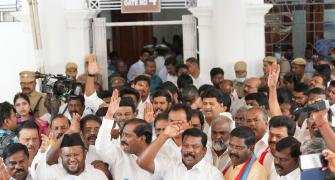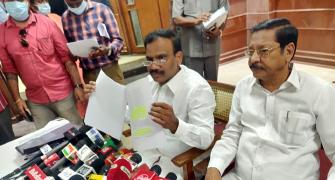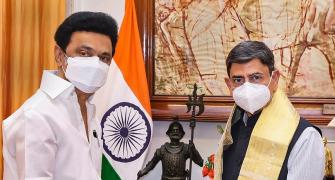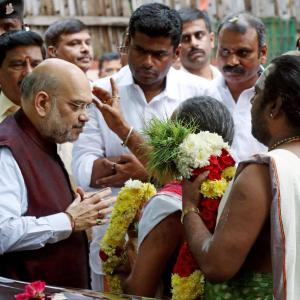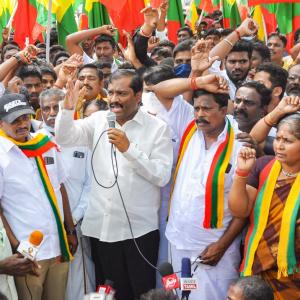Words and actions like those of R N Ravi and a vocal section of the state BJP have only added to Tamil fears and suspicions, points out N Sathiya Moorthy.

After what seems like a year-end recess, Governor R N Ravi has kick-started a row, this time with his suggestion for rechristening Tamil Nadu as 'Tamizhagam', implying that the former had a 'separatist' slant of the erstwhile Dravidian political kind.
After his party colleague and DMK parliamentary group leader T R Baalu had given what reads like a point-by-point rebuttal of the governor's observation at a Raj Bhavan reception for participants in the equally controversial Kasi Tamil Sangamam, bringing in the 'Dravidian-Aryan' divisive-discourse even more, Chief Minister M K Stalin sought to put a lid on the controversy.
At a Chennai function, he said that the state was named as such only because it was the land of the Tamils, indicating that no one needs to read too much into it, as Ravi has done.
Stalin has a point. In literary terms and practical usage, the Tamil word 'nadu' does not relate only to a nation or a nation-State, still.
It also refers to individual localities with some kind of a local governance mechanism, or what passed off as zamins, or remote villages with their societal panchayats.
Though they have no legal status in modern governance, the system is prevalent in the southern hilly district of Theni, where Varusa-nadu, for instance, is just a part of a panchayat, nothing more, nothing less.
There are such other 'nadus' in that region, with their traditional internal social systems, which also interact among themselves.
A Kerala cadre IPS veteran, Ravi should be aware of the separate district demand for 'Valluva-nadu' in northern Wayanad, or Waya-nadu, incidentally the Lok Sabha constituency of Congress leader Rahul Gandhi.
These nadus did not enjoy sovereignty at any point in time -- nor do they do so now -- for them to act like nation-States in the modern construct or under age-old traditions.
The powers of the zamindar or the panchayat ended at the border of the zamindari or the village.
The power and authority of the State rested in a 'sovereign', way above them, be it the kings of the yore or the British-India government, and later, the elected governments under the post-Independence Constitution.
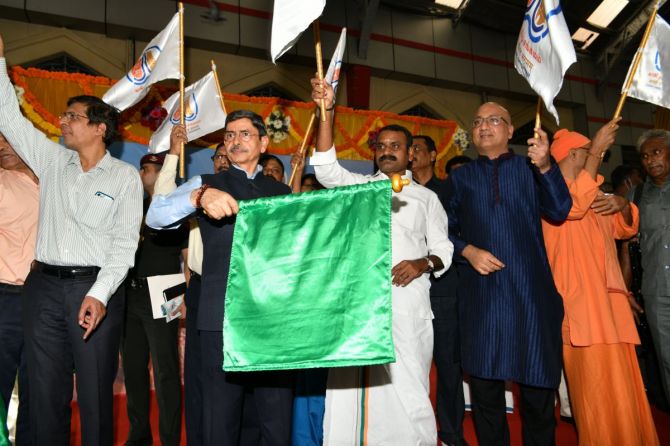
If anything, the term 'Tamil Nadu' is a linguistic construct, used in social and societal context and adapted as a politico-constitutional marker, only in 1967.
It refers only to a region with a distinctive language and culture, nothing more, nothing less.
Social historians used the term to include the Tamil-speaking enclaves in the Union Territory of Puducherry, but not under the current Constitutional scheme, which is now a Union Territory, after Independence from the French until 1954, just as there was British-India and Portuguese-India (Goa, Daman and Diu), but not anymore.
Rather, unlike what Ravi and his acolytes in the state BJP imply or indicate, the term 'Tamil Nadu' is not divisive, but a unifying factor.
Historically, the Tamil-speaking people were divided as Chera, Chola, Pandya and Pallava kingdoms, followed by the Nayaks and the Marathas, apart from a host of principalities, some of which had existed for centuries earlier.
It is only the historian's constant reference to 'Tamil Nadu' as a single linguistic-cultural entity that gave it the character that the first DMK government of party founder and chief minister, the late C N Annadurai, adopted as the state's name.
There was another reason for the name-change.
'Madras', as the state was known at Independence was the British-given name for a 'presidency', which also comprised parts of present-day Kerala, Karnataka and what became unified Andhra Pradesh, before bifurcation as Andhra and Telangana in 2014.
The re-christening was the first government order that Annadurai signed as chief minister, as he and his party had vowed before the historic assembly elections of 1967.
The re-naming of Madras state as Tamil Nadu also wily-nily put the distinctive seal of approval on the party burying the separate 'Dravida-nadu' demand, inherited from and competing with the parental DK of 'Periyar' E V Ramaswami Naicker.
Unlike often assumed, the DMK had given up the demand for a 'separate state' as early as 1960, and not after the Centre promulgating the Defence of India Rules in 1962, at the height of the Chinese aggression.
The reasons for the change-over was not far to seek.
After the incumbent Congress government of chief minister K Kamaraj had undertaken massive social welfare schemes targeting the constituency that the DMK had set its eyes on, the party was convinced, and positively, that it could do a lot for the socio-economic underdogs if elected to power.
It wanted to take the Constitutional route even more, to reach where it needed to reach to serve the masses, with the proverbial stroke of a pen.
Street protests can only be a catalyst for politico-electoral changes, and armed insurgency was not even in anyone's mind, as a certain current thinking would lead one to.
The DMK, founded in 1949, contested elections for the first time in 1957, won 15 assembly and three Lok Sabha seats.
It exposed the leadership to the possibilities and limitations, as taking the middle-path at the time was found advisable for the party's future.
There was also an implied admission that to defeat the incumbent Congress government, they needed to muster forces with the political left and the ideological right, at least initially.
More importantly, there was an early realisation that neither the Communists nor Rajaji's Swatantra Party (founded in 1959), with their overall 'nationalist intent', would touch them if they remained 'separatist'.
Though an all-embracing DMK-led front became a reality only in the victorious 1967 elections -- from which there is no looking back for the Dravidian polity -- in the 1962 assembly polls, the party improved its seat-share from the previous 15 to 50.
That sealed the 'Dravida Nadu' question for all time to come, as far as the unified DMK was concerned.
Suffice is to point out, when the late actor-politician M G Ramachandran -- MGR -- walked away from the DMK to launch a new party, he christened it only as 'Anna DMK', after the late founder of the unified party.
When during the Emergency, an unauthorised, non-official draft of the 42nd Constitutional Qmendment sought a ban on political parties with 'separatist' intent, MGR, to check against all mischievous misinterpretations, flowing from the 'DMK' tag attaching to his party, added the prefix 'all-India' to his party's name.
To date, the party has remained the 'All-India Anna DMK', or AIADMK, for short.

Over the past decade, the Vanniar-majority PMK founder S Ramadoss has been frequently reviving his demand for the bifurcation of Tamil Nadu, claiming that the state has become administratively unwieldy, to be able to reach all the services to all the people all the time.
The PMK too is a pan-Tamil party and for Ramadoss to demand bifurcation of Tamil Nadu should indicate that there is no such thing as a 'separatist' mindset, even in the post-Dravidian identity-based Tamil political evolution.
True, when Ramadoss began years ago, he very clearly linked the demand to his perception that the 'most backward' Vanniar community was the 'deciding factor' in elections to 105 of the total 234 assembly constituencies.
Later, the bifurcation of neighbouring Andhra Pradesh gave a fillip to his call, though in recent times, he has been going slow on the demand.
There was an allied reason, and this flowed from the Linguistic Re-organisation of States in 1956.
There were boundary disputes between what became the new Tamil-speaking state and the Telugu and Malayalam-speaking parts of the existing composite Madras state after Independence (which was akin to the Madras Presidency of the yore).
In fact, the Telugus wanted the capital city of Madras, now Chennai, while the Tamil activists (going beyond the DK and DMK) wanted Tirupati, too, but without yielding Madras city.
Even otherwise, unlike often assumed by the uninitiated, there were fewer Tamils among the founders of the Justice Party progenitor of the DK, DMK, et al.
The top rung was populated by Telugu-speaking zamindars and elite, apart from select Tamil and Malayalam-speaking 'intellectuals' and servants of the presidency government.
Only in the mid-thirties, after the Justice Party had lost out the electoral race to the Congress rival -- which had refused to join in earlier, since 1920 -- did the party become a champion of the Tamil cause and of the 'anti-Brahmin' cause, as different from the earlier 'non-Brahmin cause', where there was no room for hatred of the gods and religions.
All of it happened after Periyar was asked to lead the truncated Justice Party in the late thirties, after it had lost power.
He merged the Justice Party and another inheritance in the Self-Respect Movement, in the Dravidar Kazhagam, which he founded in 1944.
The rest, as they say, is history.

If the DMK's T R Baalu expanded on Ravi's provocative statement that even the word 'Dravida' was not of Tamil or south Indian origin, and belonged to Maharashtra, with his revival of the 'Aryan' discourse, non-DMK pan-Tamil leaders have been quick to criticise the governor, on the 'facts' and circumstances.
Most of them have reacted on expected party lines. Some have also pointed to the inappropriateness of the Raj Bhavan in Chennai repeatedly and almost wantonly defying healthy precedents and protocols set by his predecessors, both here and elsewhere, about the spirit of the Constitution and of the founding-fathers.
Knowingly or otherwise, the otherwise controversial state BJP President K Annamalai seems to have taken Stalin's line on this one issue.
According to him, the ruling DMK was seeking to live down its past (regarding 'separatist' demand?) only to divert people's attention from its mis-governance.
Whatever the motive, he seems to convey that he did not support the governor's suggestion.
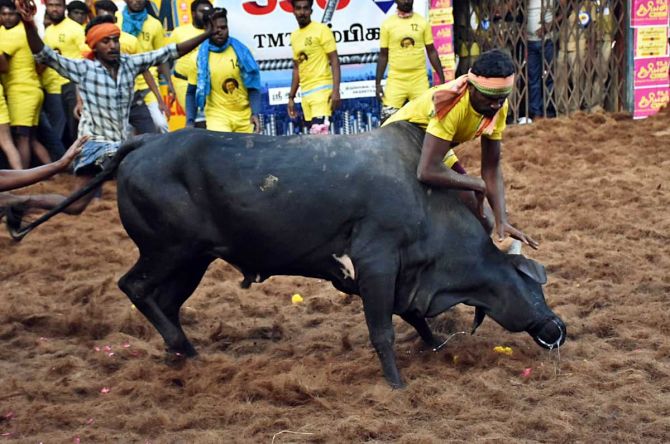
What is often missed out in the cacophony of media statements by established political parties and their ideological brethren is the undercurrent of pan-Tamil sentiments that is swelling in the subterranean class, which is not always divided by caste or urban-rural identity, as believed.
It was the cause for the mammoth and equally unprecedented Jallikattu protests in January 2017, where the uninitiated, new-generation educated classes, or the 'eighties and nineties kids', saw a common cause, sub-served only by the common Tamil identity and culture and a sense of alienation and deprivation -- by a 'domineering' Centre.
Rather than seeking to erase their apprehensions, which they have taken with them overseas wherever they work, words and actions like those of Ravi and a vocal section of the state BJP, have only added to their woes, fears and suspicions.
In an earlier era, it took the shape of the 'anti-Hindi' agitation, which the Opposition DMK exploited effectively, in the India of the sixties, but within the four corners of the constitutional scheme.
Today, social media posts and campaigns, within and outside of the existing political spectrum.
It is similar to what the NRI Hindutva community especially had started in the early years of the previous decades, which their counterparts nearer home adapted and improved upon, with each passing election.
If the apolitical pan-Tamil protagonists would not let the political class hijack their Jallikattu initiative, putting their high-paying MNC-driven IT jobs in the line, the state government agencies did not have much of a clue about the under-currents until it all blew on their face.
Better or worse still, with the ruling Dravidian polity rather having outlived their identity but not more contemporary utility, the new generation that was born with a spoon -- whether silver or not -- was being brought up in an ideology-free environment.
But with Jallikattu and constant 'provocations' from the likes of Ravi, that the government has revived all over again, and distanced from the mainstream Dravidian polity, over which the nation soon may have lost touch, with.
It is already happening, in a small or big way!
N Sathiya Moorthy, veteran journalist and author, is a Chennai-based policy analyst and political commentator
Feature Presentation: Ashish Narsale/Rediff.com

